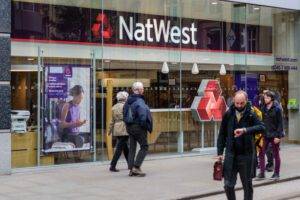The UK government’s 16-year journey to exit its crisis-era investment in NatWest Group is approaching its conclusion, with the Treasury announcing its shareholding in the lender has dropped below 1%. As of the latest filing with the London Stock Exchange, the government now holds just 0.9% of the bank, down from 1.98% at the end of April. This milestone symbolically closes one of the most significant chapters of the 2008 financial crisis — the nation’s multi-billion-pound bailout of one of its largest banks.
The reduction in government ownership is part of a managed share trading plan introduced in 2021, designed to gradually sell its stake without destabilising the market. The strategy now appears to be nearing completion, with shares steadily sold in the open market in recent months rather than via large, one-off disposals. This method aims to keep the bank’s share price stable and avoid volatility often associated with substantial block sales.
NatWest — previously Royal Bank of Scotland (RBS) — became one of the most emblematic casualties of the global financial crisis. In 2008 the UK government was forced to rescue the institution with a £45.5 billion capital injection, ultimately acquiring an 84% stake in what became the largest banking bailout in British history. [According to the House of Commons Library](https://commonslibrary.parliament.uk/research-briefings/sn05723/), the government’s interventions during the financial crisis also included multi-billion-pound rescue packages for Lloyds Banking Group, Northern Rock, and Bradford & Bingley.
Despite a gradual improvement in NatWest’s financial health, the taxpayer has realised a loss on every tranche of shares sold since then. The government’s average purchase price during the bailout stood at 502p per share. While NatWest shares edged up to 498p on Thursday — their highest in years — they still trade just shy of the breakeven mark. The disposal of shares below this price confirms that the cost of bailing out the bank will not be fully recovered. Collectively, it is estimated by the National Audit Office that the taxpayer has incurred a loss of over £30 billion on the RBS bailout when accounting for inflation and funding costs.
Nevertheless, ministers and the bank itself have framed the full return to private ownership as a success. Speaking on Thursday, a NatWest spokesperson said: “Returning the bank to full private ownership is an ambition we share with the government, and one that we believe is in the interests of all our shareholders.” The Treasury echoed this sentiment, with officials viewing the exit as a final unwinding of the emergency crisis measures that kept Britain’s financial system afloat during a period of unprecedented instability.
The government’s initial step towards reprivatising NatWest occurred in 2015 under then-Chancellor George Osborne, with a modest sale of shares to institutional investors. Since then, successive governments have taken a cautious approach to further divestments, wary of unfavourable market conditions and the political sensitivity of selling state-owned assets at a loss. Lloyds Banking Group — which was also bailed out during the crisis — returned to full private ownership in 2017, marking an earlier wind-down of its state ties.
The closing stages of the NatWest stake sale come at a time of strategic transformation for the bank. Under the leadership of Chief Executive Paul Thwaite, appointed permanent CEO in 2023 following the departure of Dame Alison Rose, the bank has embarked on a renewed growth plan. Recent moves include the acquisition of most of Sainsbury’s banking operations and the purchase of a £2.5 billion mortgage book from Metro Bank. Although a recent bid to acquire Santander’s UK high street branches was unsuccessful, the attempted deal underscored Thwaite’s appetite for bold M&A activity as NatWest explores ways to grow market share organically and through acquisition.
NatWest has also reported robust annual profits in recent quarters — its strongest since before the 2008 collapse — buoyed by higher interest rates and a renewed focus on core domestic banking. In 2023, the bank posted an annual profit of £5.1 billion, its highest since 2007. The Bank of England’s monetary tightening cycle has helped improve bank margins; however, as interest rates stabilise, lenders such as NatWest face new challenges including mortgage affordability pressures and slowing credit growth.
Nonetheless, analysts and investors increasingly view the reprivatisation as a major turning point in the bank’s history — a symbol that it has recovered not only financially but reputationally from its damaged legacy. The bank, once derided as a poster child for reckless lending and toxic acquisitions like its ill-fated purchase of ABN Amro, now operates with a significantly trimmed balance sheet, simpler structure, and more conservative risk approach.
With the Treasury poised to offload its final fraction of shares in the coming weeks — possibly timed to more favourable market conditions or political considerations — Britain is set to close




